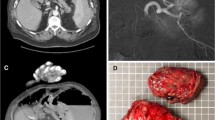Abstract
For non-operative management of splenic injuries in children, questions remain as regards imaging, length of hospital stay, and follow-up. We reviewed our experience concerning these issues over the past 15 years. The charts of all children with splenic injuries from January 1983 to December 1998 were reviewed. All computed tomography (CT) scans were reviewed and classified according to degree of splenic injury. Fisher's exact test and a linear regression model were used to analyze data. Sixty-nine males and 23 females under 16 years of age were identified; 57 (62%) had CT scans; 8 underwent a laparotomy; and 6 (6.5%) died. Age, on hemoglobin admission, and duration of intensive-care-unit stay were significantly related to hospital stay (median 8 days). Motor vehicle-pedestrian-related injuries correlated significantly with mortality. CT class did not correlate with mortality (P=0.68) or hospital stay (P=0.2). Follow-up data were available for 66 patients, 36 of them with imaging. Follow-up imaging did not impact on clinical decisions and no late sequelae were identified.
Similar content being viewed by others
Author information
Authors and Affiliations
Additional information
Accepted: 19 June 2000
Rights and permissions
About this article
Cite this article
Al-Shanafey, S., Giacomantonio, M. & Jackson, R. Splenic injuries in children: Correlation between imaging and clinical management. Pediatr Surg Int 17, 365–368 (2001). https://doi.org/10.1007/s003830000513
Issue Date:
DOI: https://doi.org/10.1007/s003830000513




